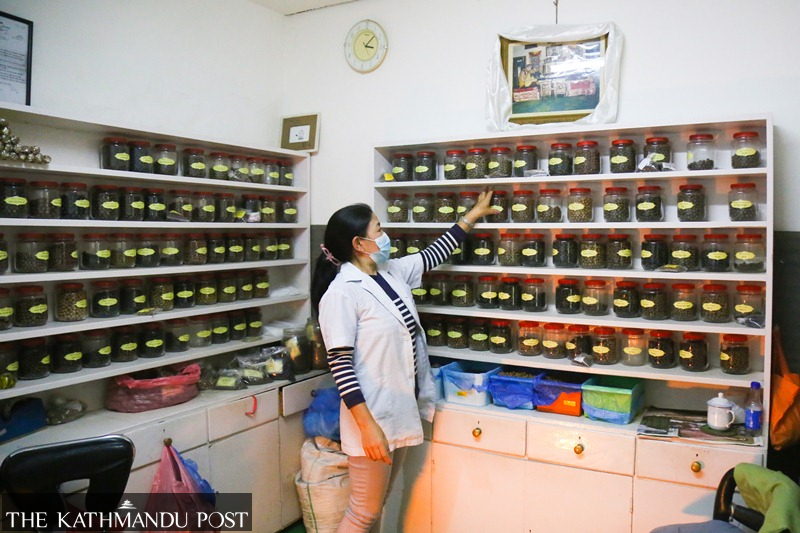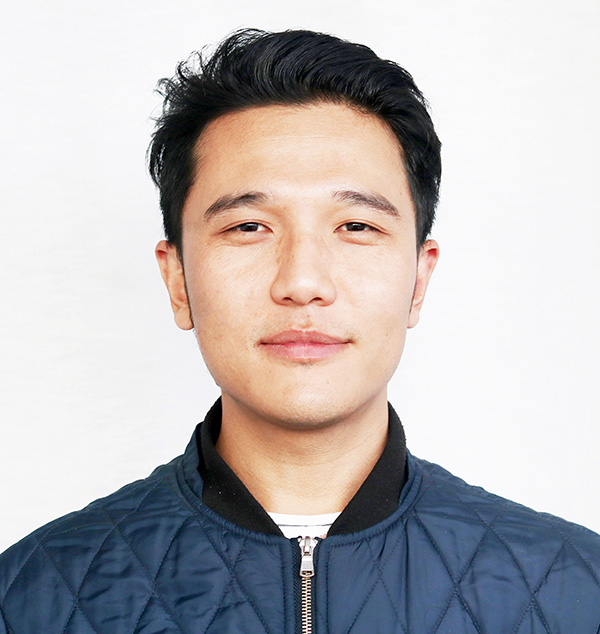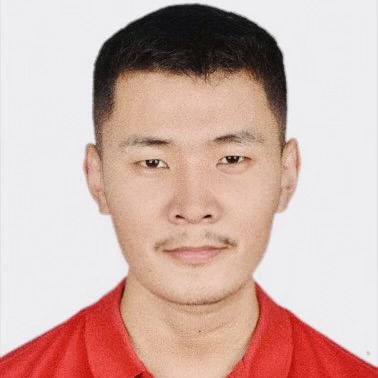Culture & Lifestyle
Sowa Rigpa: An alternative medicine’s expansion beyond the Himalayas
Once prevalent only in Nepal’s mountainous districts, the traditional medical system is now finding acceptance by communities across the country.
Tsering Ngodup Lama & Pasang Dorjee
When 51-year-old Bishwa Nath Oli visited Swayambhu's branch of Phende Clinic in February this year, he wasn’t entirely sure of what to expect. At the time, Oli suffered from painful gout caused by high uric acid levels, a medical condition that he had for almost ten years. After trying different treatment methods to stabilise his uric acid levels and failing to do so, Oli’s friend suggested visiting Phende Clinic and consulting with Dr Tenjing Dharke Gurung.
“After several consultations with Dr Tenjing and taking his medicines for almost six months, my uric acid stabilised, and my pain was completely gone,” said Oli during one of his regular visits to the clinic a few weeks ago. “Since the treatment completely worked on me, I have been suggesting friends and families who suffer from similar health conditions to visit Phende Clinic and give Sowa Rigpa a try.”
Sowa Rigpa is a traditional medical system that dates back more than 2,000 years and is heavily influenced by Buddhist philosophy. Sowa Rigpa healers are traditionally known as amchis, but many of them these days use the title doctor before their names. In certain mountainous districts of Nepal and India, the medical system is better known as the ‘Amchi system of medicine’. While in many parts of the world, it is better known as traditional Tibetan medicine. Apart from Nepal’s mountainous districts, Sowa Rigpa, often translated into English as ‘the science of healing’, is widely practised in India, Bhutan, China, and Mongolia.
For centuries, for the people living in Nepal’s mountainous districts, this medical system was the only accessible medical system. But in the last few decades, as more people from the region started migrating to cities like Kathmandu and Pokhara in the hopes of better employment and education opportunities, a handful of Sowa Rigpa clinics started operating in these cities to cater to the diaspora. In the last few years, however, the number of Sowa Rigpa clinics in these cities has increased, but a large number of patients that these clinics cater to are from communities that did not historically rely on the medical system.

The first registered Sowa Rigpa clinic in the country was Kunphen Ausadhalaya, established in 1973 and located in Chhetrapati, Kathmandu.
“The royal palace invited renowned Amchi Kunsang Phentok to Kathmandu to treat the then King Tribhuwan who was suffering from chronic liver disease. Amchi Kunsang successfully treated the late king, and that’s how the first registered Sowa Rigpa clinic in the country came into being,” said Dr Nyima Tsering Nepali, who is one of the two Sowa Rigpa doctors currently working at Kunphen Ausadhalaya. “In those days, the majority of patients who came to our clinic were Kathmandu’s elites and those connected with the royal palace and people from Nepal’s mountainous districts who had migrated to Kathmandu. But a lot has changed in the last few decades. Today, people from across the country and foreigners residing in Nepal visit our clinic.”
Sowa Rigpa doctors like Dr Gurung and Dr Nepali are trained to diagnose patients using various diagnostic techniques. “Some of the most common techniques Sowa Rigpa doctors use to analyse patients are by examining their pulse, tongue, and urine,” said Dr Gurung. “The medicines are all made using products that are found in nature and following the system’s centuries-old tradition.”
It was 2012 when Dr Gurung established Phende Clinic in Swoyambhu. For the first two years, most of his patients were people from the indigenous communities of Nepal’s mountainous districts. Every once in a while, says Dr Gurung, people from other communities would come to the clinic seeking healthcare.
“But a lot has changed in the last few years. At my clinic in Swoyambhu, I see an average of 80 patients, and around 70 percent of them are from communities in the hills and Tarai region of the country, both of which did not traditionally rely on Sowa Rigpa,” said Dr Gurung.
This growing acceptance of Sowa Rigpa as a medical system among people from across the country encouraged Dr Gurung to open branches of Phende in Dharan, Jhapa, Syangja, and Pokhara.
Part of the reason the medical system has been steadily gaining popularity seems to be its efficacy and affordability. Saraswati Rashmi Shakya, a student of Buddhist Studies, details her experience with Sowa Rigpa over four years with The Post as; “I had a harrowing condition of thyroid for which I sought treatment from several hospitals around Kathmandu. The medicines that I had been prescribed simply exacerbated my emotional state, as I would often feel down and dejected after taking it. Until, of course, I discovered Sowa Rigpa, and it drastically improved my situation. Although I had to be patient with the overall process, it was absolutely worth it in the end.” Shakya claims to have been introduced to this practice by one of her friends studying to become an amchi in India. Her treatment, however, began at Chhetrapati’s Men-Tsee-Khang, which operates several branches of Sowa Rigpa clinics in Nepal. The chief Sowa Rigpa doctor of Men-Tsee-Khang’s Chhetrapati branch is Dr Dhindup Tsering Tamang Lama (Daniel).
Dr Daniel started his practice in 2018 after graduating from Men-Tsee-Khang (Sowa-Rigpa) Tibetan Medical and Astro College in Himachal Pradesh, India. All three doctors the Post talked to for the story studied Sowa Rigpa in India.

Until 2016, Nepal didn’t have a dedicated university-affiliated Sowa Rigpa college and that’s the reason why, say Sowa Rigpa doctors the Post talked to, many went to study at Sowa Rigpa institutes in India.
“We knew that if we were to preserve and promote Sowa Rigpa in Nepal, it is crucial to have a dedicated government-recognised educational institute in the country so Nepal can produce qualified and well-trained Sowa Rigpa doctors right here in the country. After years of hard work, Sowa Rigpa International College, an affiliate of Lumbini Buddhist University, opened in February 2016. It is the only institute in Nepal to offer a Bachelor’s degree in Sowa Rigpa Medicine [BSM],” said Dr Gurung, who also serves as the college’s director.
According to Dr Nepali, who serves as the college principal, the institute has been able to attract international students from Bhutan, Finland, India, Spain, and England. “In the past, only people from Himalayan communities would study to become Sowa Rigpa doctors, but this is no longer the case. We not only have international students but also local students from non-Himalayan community backgrounds. This is an encouraging sign,” said Dr Nepali. “The college is a not-for-profit organisation and the main aim is to provide quality education to our students. We also provide attractive scholarships to deserving students. For the first four and a half years, our students undergo rigorous academic training, and in the final year, they intern at recognised Sowa Rigpa clinics.”
Nonetheless, the word-of-mouth publicity that helped proliferate Sowa Rigpa, as well as its effectiveness, has truly bolstered its credibility and overall reputation.
While Sowa Rigpa has permeated beyond the Himalayan communities of Nepal only in the last few years, it is well worth noting that this tradition had taken root in the Western world decades earlier. This system of medicine has also pervaded several parts of India over the past two decades. With the Indian government bolstering the infrastructures by incorporating Sowa Rigpa within educational institutions and hospitals, this practice has steadily been making its way into the mainstream.
Stewart Mushet, a Scottish based in Malaysia, who sought Sowa Rigpa treatment through a friend’s referral, urges everyone to approach it with an open mind. “People generally tend to perceive natural treatment as being like an antithesis to Western medicines. I would strongly advise anyone seeking Sowa Rigpa to break out of that binary thinking. You can follow your clinically prescribed medicines while simultaneously taking Sowa Rigpa medicines as well,” said Mushet. “Sowa Rigpa is not a competition against Western medicines, but rather a complementary treatment.”
At his clinic in Chhetrapati, Dr Nepali sees dozens of patients daily. “The majority of the patients who come to our clinic are those with chronic non-communicable diseases such as diabetes, hypertension, thyroid, arthritis, etc. Given that Sowa Rigpa clinics have never promoted their services, it surprises me to see people from such diverse parts of the country come and seek medical treatment at our clinic. Those from economically marginalised backgrounds can also get free-of-cost medical care at our clinic if they furnish a letter from the local government stating their case,” said Dr Nepali. “As Sowa Rigpa doctors, we are trained to look at our profession as an altruistic endeavour where the main goal is to relieve people’s sufferings, which is the core of Buddha’s teachings. As the people of the land where Buddha was born, we should protect and promote this unique medical system.”




 22.65°C Kathmandu
22.65°C Kathmandu
















